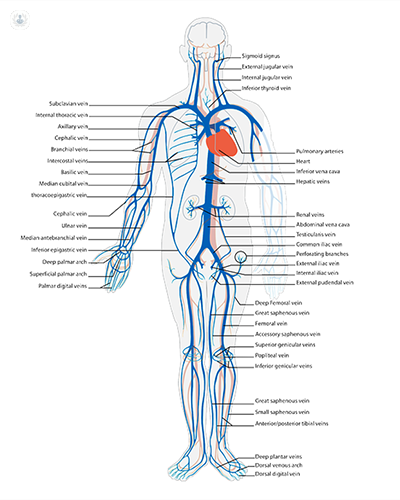Abdominal aortic aneurysm (AAA): Your questions answered by an expert
Written in association with:In this informative article, leading consultant vascular surgeon Mr Maziar Mireskandari shares his expert insight on abdominal aortic aneurysm, including the associated causes and symptoms of this condition. In addition, the revered specialist sheds light on the function of the aorta within our circulatory system and how this is affected by aneurysm, and also details when intervention is required.

What is the aorta?
The main artery that transports blood from the heart to various parts of the body is known as the aorta. Resembling a hockey stick in shape, it is connected to the heart at one end and extends from the chest into the abdomen like a hose pipe, branching out to different organs along its length. In the pelvis, it divides into two branches, each supplying one leg. Towards the base of the neck, it emits branches that reach the head and the arms.
The abdominal aorta emits two branches (the coeliac artery and the superior mesenteric artery) that provide blood to the stomach, liver, pancreas, spleen, and the majority of the intestines. Below these two branches, there are two additional branches, each supplying one kidney. Further down, there is the final branch (the inferior mesenteric artery) that nourishes the remaining lower intestines.
The aorta has numerous tiny branches running throughout its entire length that provide blood supply to the spinal cord (which can be considered as an extension of the brain). These branches are referred to as the lumbar arteries in the abdominal region.

What is an aneurysm?
An aneurysm refers to the enlargement or swelling of a blood vessel. When the blood vessel expands to a size more than 2-2.5 times its normal diameter, it is considered an aneurysm.
The most frequently encountered aneurysm requiring attention from vascular surgeons is the abdominal aortic aneurysm. There are various different types of aneurysms, affecting different parts of the circulatory system. To learn more, visit my website which has further information on aortic and thoracic aneurysms.
What is an abdominal aortic aneurysm?
Abdominal aortic aneurysm (AAA) is an expansion of an aneurysm in the abdominal section of the aorta. The most frequent location for AAA occurrence is within the infrarenal part of the abdominal aorta, specifically below the point where the branches leading to the kidneys branch out.
The typical diameter of the abdominal aorta is approximately 2 cm. Hence, a measurement exceeding 4 cm is regarded as indicative of an aneurysm. You can learn more about abdominal aortic aneurysms by visiting my website.
What can cause an abdominal aortic aneurysm?
Abdominal aortic aneurysms have multiple factors involved. Various pathways can jointly increase a person's likelihood of developing AAA. Here are some of the factors that can contribute to AAA:
- Inherited genetics (aneurysms may be hereditary)
- Genetic anomalies (certain conditions like Marfan syndrome, Ehlers-Danlos syndrome, Loeys-Dietz syndrome, Takayasu arteritis, Behçet's disease)
- Smoking
- High blood pressure (hypertension)
- High cholesterol
AAA is more likely to occur in those over 60 years of age and is more common in men than women.

What are the symptoms?
In the majority of cases, an AAA presents no symptoms, and the individual remains oblivious to the ailment. Frequently, such cases are revealed during radiological examinations conducted for another reason, such as a CT scan performed to check the kidneys.
In some patients, AAA can manifest in symptoms such as abdominal or lower back pain. Any persistent symptoms of this type should be treated with due concern and investigated.
In a small subset of patients, the first indication of an aneurysm only occurs when it ruptures, causing acute and extreme abdominal or back pain. This is a very serious and can be life threatening if not treated immediately.
When should an abdominal aortic aneurysm be treated?
Following a comprehensive consultation with your vascular surgeon, a decision can be made about whether or not to pursue treatment. In the majority of cases, a decision for treatment relates to the size of the abdominal aorta with the objective of preventing a rupture. The general consensus amongst vascular surgeons on threshold size at which treatment should be considered is 5.5 cm. However, there are some other factors to consider:
- In women (who typically have a smaller abdominal aorta), treatment may be considered at 5cm.
- For patients with genetic abnormalities, the threshold size for treatment may also may be lower.
- In cases where the aneurysm is expanding at a rapid rate, treatment may be considered at a smaller size.
- All patients with AAA symptoms should be considered for treatment irrespective of aneurysm size.
Should I be screened for an abdominal aortic aneurysm?
In the UK, men living in England receive an AAA screening postal invitation on their 65th birthday. In screening for abdominal aortic aneurysms, ultrasound scanning is used which is a quick and painless investigation.
Any woman or man younger than 65 can also be considered for screening if they have a family history of AAA.
To learn more about treatment for abdominal aortic aneurysm, read Mr Mireskandari’s follow up article on surgical intervention. You can also find extensive information on Mr Mireskandari’s website.
If you are concerned about abdominal aortic aneurysm and wish to schedule a consultation with Mr Mireskandari, visit his Top Doctors profile.



